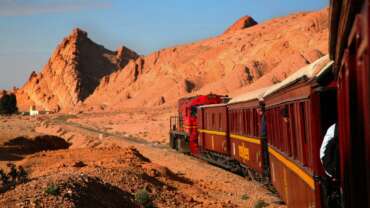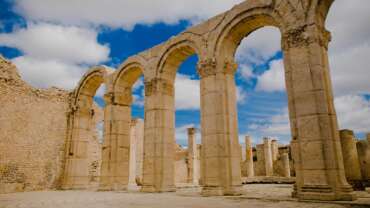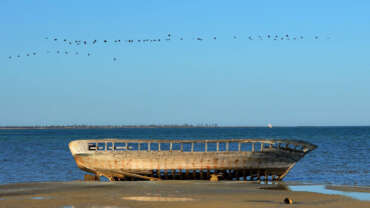Tunisia - Rich in Culture!
Carthage
Carthage’s successor, Tunisia is an ancient civilisation, enriched by different cultures through the ages. By visiting the country and its museums you can admire the prolific creativity of Roman and African mosaic artists, the powerful beauty of the El Djem Amphitheatre and the Great Mosque of Kairouan, the delicate elegance of the Capitol in Dougga or the palaces in Tunis, the moving simplicity of Djerba’s architecture… You can find out about the Berber traditions that still continue today, lifestyles that have adapted to the most hostile of environments and the incredible variety of customs and crafts. You can also familiarise yourself with a modern culture with its arms outstretched to the rest of the world.
Universal Heritage
Over its history, Tunisia has always walked the fine line between Africa, the East and the West. Medinas, fortresses, Roman remains… seven sites and monuments are UNESCO World Heritage sites, thanks to their cultural value: Carthage, Dougga, El Djem and Kerkouane and the medinas of Tunis, Kairouan and Sousse.
Tunisia has managed to maintain a wonderful balance between its many different influences. Refugees from Andalusia, craftsmen from Italy and Turkish commanders have all left their mark. That’s why Testour’s minarets remind us of Spanish architecture, the ceramics in Kairouan include Ottoman motifs and the tombs of the Beys – the rulers of Tunis – are decorated with marble in the style of the Italians. Similarly, emancipated African slaves are behind a specific musical style known as “stambali”. This cultural richness can also be found in the food, with Berber, Andalusian, Jewish and Italian roots


Museums
The most amazing museum of mosaics in the world can be found in Tunis, in the former Bey palace, the Bardo, comprehensively renovated and extended in 2012. This museum houses a unique collection of Roman antiques. Take the time to marvel at the countless masterpieces of Tunisia’s mosaic artists, who were the most renowned in the Roman world.
Still in Tunis, visit the Sidi Qacem Jellizi ceramics museum, dedicated to a 15th century master ceramicist, and the Museum of Popular Art and Traditions, housed in the Palace of Dar Ben Abdallah. In Carthage, the archaeological museum boasts some really exceptional exhibits, including a sculpted sarcophagus and a small statue of the god, Baal. Depending on your particular area of interest, you can choose between Carthage’s Oceanographic Museum and the museum of musical instruments in Ennejma Ezzahra, in Sidi Bou Said.
In the North West of the country, the modern Chemtou Museum offers lots of information about Numidia, an ancient indigenous civilisation that flourished alongside Carthage (and is actually home to the remains of a temple dedicated to the Numidian King, Massinissa). The Museum of Popular Art and Traditions in Kef is housed in a stunning 18th century religious building. It is a mine of information about the equestrian tradition, clothing and jewellery from the North West and life in Bedouin tents.
In Kairouan, the Raqqada Museum presents some incredibly valuable medieval pieces, including lustre-glazed ceramics and manuscripts such as the famous Blue Qur’an.
Sousse boasts a first-rate archaeological museum with some exceptional Roman mosaics. Also worth visiting are the reconstruction of a Roman villa in El Djem and the museums of Popular Art and Traditions in Sousse, Monastir and Mahdia.
In Sfax, the former Kasbah is now a museum dedicated to historic architecture; the Dar Jallouli Palace is an understated, majestic 17th century house, where you’ll find beautiful objects that once graced the homes of well-to-do families. In Djerba, the Traditional Heritage Museum is dedicated to different aspects of life on the island (clothes, pottery, agriculture, fishing), while the Guellala Museum focuses on scenes from traditional life.
Contemporary Culture
At the beginning of the 20th century, new European architectural trends arrived in Tunisia’s towns and cities. Art Nouveau, Art Deco and Arabisance crept into Arabic architecture. In the 1940s, a modern school of Tunisian painting was born, the Tunis School. Today, there is a real explosion in artistic expression. Photography, plastic arts, performances and installations are regularly showcased in art galleries and public spaces during the Dream City biennale. Tunisian theatre, born in the 1910s, explores new territories, as does contemporary dance, music and cinema, celebrated by a Pan-African festival founded in 1966.


Unmissable sites
Carthage
Legend has it that Carthage (north of Tunis) was founded by the Phoenician Queen Elissa, also known as Dido, in 814 BC. Longstanding rivals of the Greeks, the Carthaginians – also known as the Punics – were in control of a network of trading posts in the Mediterranean, from Spain to Sicily. The Romans destroyed the city in 146 BC, then rebuilt it and made it the capital of the rich province of Africa. Some fragile remains of Punic Carthage can still be seen today: the areas where Mago and Hannibal lived and the Punic ports. The Roman ruins show the city’s opulence: the Baths of Antoninus, whose main room was 30 metres tall and whose cisterns had a capacity of 60,000m3, and the Basilica of Damous El Karita which was the largest in Africa, as well as many more.
Kerkouane
Punic civilisation has held on to many of its secrets. Carthage itself has only held on to a few rare vestiges of this time. Which is why Kerkouane (in Cap Bon) is so important. It has never been rebuilt since it was abandoned in the 3rd century BC. Kerkouane is a Punic Pompeii: you can see the typical urban layout of a small Carthaginian town. The wide, regular streets lead into squares and courtyards; the great gods of the Punic pantheon – Baal, Tanit, Ashtart, Eshmun and Melqart – were worshiped in an open-air sanctuary.
Dougga
The archaeological site of Dougga is one of the most spectacular in Tunisia. Its ruins are surrounded by olive trees and nestled into a cliff facing a slightly inclined plateau; over 70 hectares, they trace out the contours of an almost completely preserved Roman town. Once a royal Numidian town, in Roman times, Dougga, or Thugga, was adorned with decadent monuments: the Capitol, whose pediment bears a depiction of Emperor Antoninus’s elevation to godhood, the 3,500 seat theatre, the Temple of Juno Caelestis encircled by a semi-circular portico, where the Carthaginian goddess, Tanit, continued to be worshipped in secret. These monuments date back to the 2nd and 3rd centuries, a time of great prosperity for Roman Africa, and they are some of the best preserved of the whole Roman world.
El Djem
Not many ancient sites are as impressive as the Roman Coliseum at El Djem. In this enormous amphitheatre, inspired by the one in Rome and architecturally flawless, epic entertainment was put on pitting hunters against wild animals.
Medinas
Although the medinas of Tunis, Kairouan and Sousse are UNESCO World Heritage sites, there are plenty of others that are well worth a visit, including the one in Sfax.
The medina in Tunis boasts a stunning example of 9th century architecture, the Ez-Zitouna Mosque, as well as many other monuments dating back to the Ottoman Empire including the Hammouda Pacha Mosque, the Madrasa Slimania and the tomb of the princess Aziza Othmana. The Art Nouveau, Art Deco and Arabisance buildings around the medina are also worth checking out.
The medina in Sousse is staggered up the side of a hill facing the sea. It is a real treat to explore the narrow little alleyways with their bygone atmosphere and haggle in the souks. Overlooked by the imposing silhouette of the Khalef Tower, the old town has managed to preserve its medieval ramparts and many monuments that bear witness to its past as a stronghold: the Ribat, a small fort and religious retreat, the Grand Mosque that looks like a fortress and the imposing Kasbah.
In the medina in Kairouan, the Great Mosque is well worth a visit: non-Muslims are allowed to enter the courtyard and see the prayer room, a majestic forest of arches and ancient columns. You can also climb up the minaret, inspired by the Lighthouse of Alexandria. You’ll be amazed by the power and simplicity of this 9th century architecture. The contrast is striking between that and Kairouan’s other great monument: the graceful Zaouia of Sidi sahib (or “Barber’s Mosque”), whose wide courtyards are decorated with brightly coloured stones.
The medina in Sfax is one of the best preserved in the whole of the Mediterranean basin, and is laid out like a typical old Arabic town. Its crenelated battlements, built in the Middle Ages, are studded with huge doors: the oldest ones were built as defences to hold back invaders. The Great Mosque, built in the 9th century, occupies a central position.










